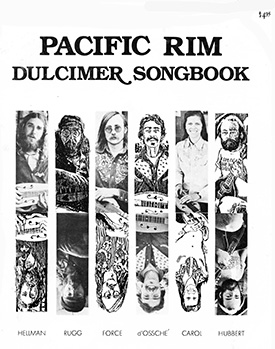Pacific Rim Dulcimer Songbook
Dusty Moose Publishing
The instruction on these pages creates a solid foundation upon which to build an understanding of the commonly used American Appalachian Mountain dulcimer tablature system. They also present an introduction to the fundamentals of the reading/writing notation used for all modern music.
The “how to read music and dulcimer tablature” excerpts from this 1977 book was the collective effort of seven dulcimer players grappling with how to explain what and how we did what we did, striving to make it understandable to the novice player. In short, the first comprehensive methodology of mountain dulcimer instruction was invented. All six of the “named” authors went on to have music careers, five centered around the dulcimer. Many subsequent books traded on, rewrote, or otherwise re-packaged this content. But this is the original. Modern dulcimer tab was born in these pages.
Most of us were explaining to ourselves how we perceived it was that music worked. Devices like visualizing a ruler and marking it off in incremental spaces to indicate time passage and using “equations” to explain quarter notes (as compared to eighths) were used. Waveform diagrams were drawn to present an understanding of harmonics and why octaves and fifths and fourths worked mathematically. These weren't new ideas but rather a synthesis of theory in the context of the dulcimer.
Each of us brought a piece to the puzzle. We used the tunes we had released earlier in the year on the Pacific Rim Dulcimer Project as our template. The book used several different approaches, depending on the artist and what they considered the most important to know about learning their song-- was it the chords, or needing to read the musical staff, or following a tablature, the way the rhythm worked, strum direction, finger picking sequences?-- each had its debut in the book.
Five of the six of us were at the first Kindred Gathering Festival held the year previously-- Force, d'Ossche', Carol, Hellman and Rugg. After that initial meeting, Bonnie Carol proposed we make an album together. A year and a half later it happened at Biscuit City in Denver, Colorado. Michael Hubbert came as a guest artist with Rugg. We cut tunes separately and together. This was to become the first widely distributed dulcimer record of the era. It was later resold to two other record labels.
At the second KG in Colorado, Baila Dworsky attended. Her background as a college-trained, degree holding, multi-instrumentalist was a boon to all of us. As she learned to play the dulcimer from us she was able to “translate” much of our techniques and explanations, aligning them with standard music terminology and practices. Her contribution to the book was invaluable. Although credited as a transcriptionist, not as a co-author, she was given 1/7th of the share of the book.
Other people listed as transcriptionists were Sally Hellman, Harriet Jacoff and Michael Hubbert. Michael and Sandi Rugg did the graphics. Jaki Reed and Michael Rugg were the illustrators. Other contributors were photographers Michael Sheehan, JoEllen Lapidus, Bob Koutnik and, again, Rugg. Michael was the co-owner of the Capri-Taurus dulcimer company. A trained graphic artist, much of the detail of getting the book out fell to him. He invented Dusty Moose as his publishing company.
We sat around Michael's big kitchen table, deep in the Redwoods outside of Felton, California in the Spring of 1977, and put it all together. The self-released book went through three printings. The first two had a sepia-tone cover; the third and final had a black and white cover. Other books and many recordings were yet to come from this group, including Baila, but never again as a collective effort.
Here at this website I have not duplicated the song pages of the other artists-- just the joint work of our deciphering music and creating a tablature system for the instrument. In the Songs & Tunes List section of this site, the selections that Albert d'Ossche' and I played on the PacRim LP, and later tabbed for the PacRim book, appear as they do in the original book. These are: Wellyn 1977, Cornwall 1977, Firenze 1977, Sing Sailor 1977, Poker Face Smile 1977 and Ananta 1977. The 1977 date is to distinguish them from a recut of the same tune, most of which were released on subsequent albums.
